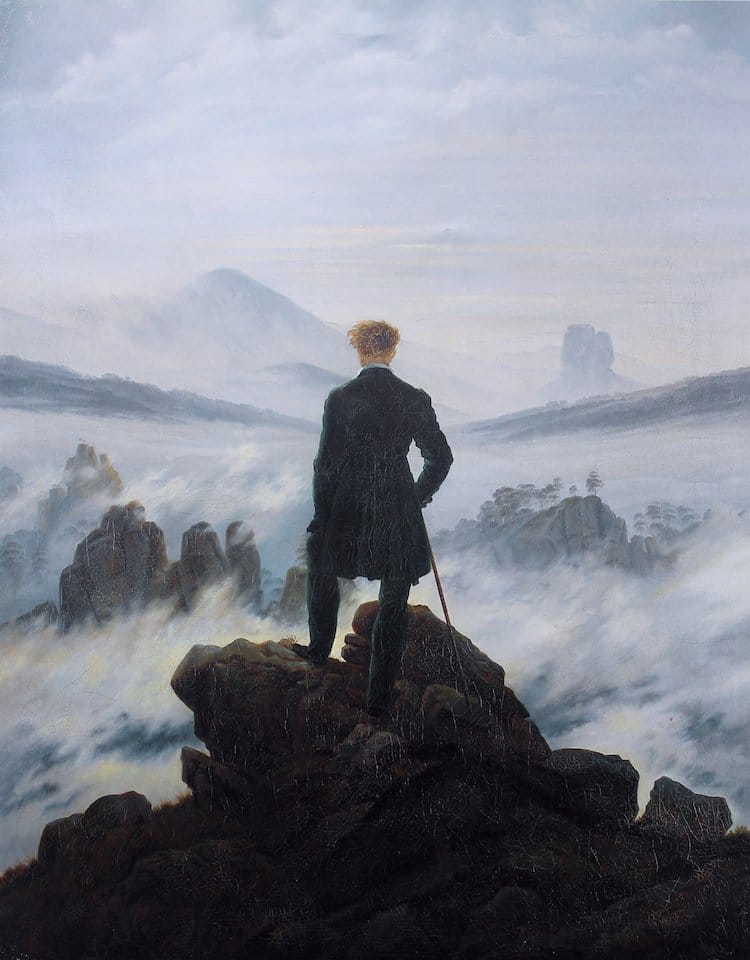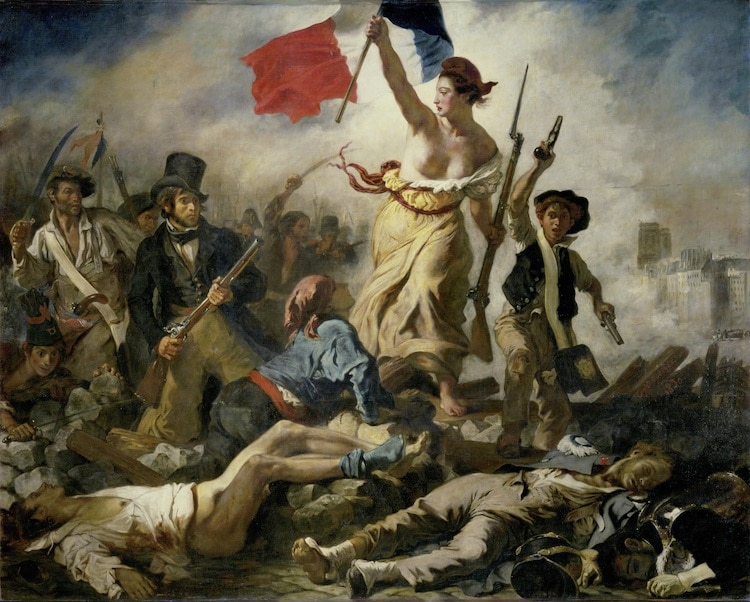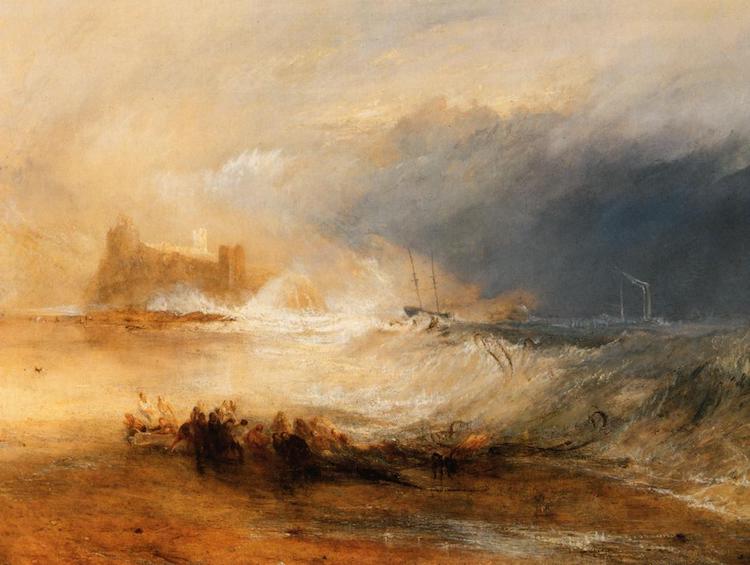Romanticism Art in the 1800s Romanticism Art in the 1800s

Caspar David Friedrich, 'Wanderer Above the Bounding main of Fog,' ca. 1818 (Photo: Wikimedia Commons Public Domain)
Throughout fine art history, many major art movements emerged in response to existing artistic approaches. Pre-Raphaelite painting, for example, was born out of a dislike of the Renaissance, while Rococo artists built upon the opulence of Baroque art. Though this phenomenon has manifested fourth dimension and time over again, information technology reached a tiptop with the onset of Romanticism, a move that rejected the formality of Neoclassicism and, instead, embraced emotion.
Today, the Romantic genre is mostly associated with large-scale paintings. However, the movement influenced several disciplines and branches of study, culminating in a legacy axiomatic in the visual arts and beyond.
What was the Romantic Period?

Eugène Delacroix, "Liberty Leading the People," 1830 (Photo: Wikimedia Commons Public Domain)
Romanticism was a cultural movement that emerged effectually 1780. Until its onset, Neoclassicism dominated 18th-century European art, typified by a focus on classical subject area matter, an interest in artful austerity, and ideas in line with theEnlightenment, an intellectual, philosophical, and literary move that placed accent on the individual.
While Romantic figures agreed with the Enlightenment's interest in individualism, their approach diverged from the Neoclassicists. Instead of looking back to classical models, artists likeJoseph Mallord William Turner, Eugène Delacroix, Theodore Gericault, Francisco Goya, and Caspar David Friedrichinstitute inspiration in their own imaginations. This introspective approach lent itself to an art course that predominantly explored the spiritual side of humanity, the sublimity of nature, and, above all else, the fruits of personal liberty.
"If by 'romanticism' one ways the gratuitous manifestation of my personal impulses, distancing myself from the rules set in schools, and my distaste for the recipes of the university," Delacroix famously remarked, "I must confess that not only am I a romantic, I was from the historic period of 15."
Romantic Paintings

"Wreckers, Declension of Northumberland," c. 1834 (Photo: Wikimedia Commons Public Domain)
In general, Romantic artists worked in one medium: paint. Specifically, in the movement'south early on years, these figures predominantly focused on landscape painting. The Romantic landscape genre was primarily pioneered by JMW Turner, a British oil painter, watercolorist, and printmaker. Early on in his career, Turner was associated with the Neoclassical motion, just a trip to the Swiss countryside sparked an artistic involvement in nature, which materialized as an imaginative and untraditional approach to painting.
"A master of history, landscape and marine painting, he challenged the way of the old masters, trailblazing in technique and field of study matter," the Tate Britain explains. "Turner often shocked his contemporaries with his loose brushwork and vibrant color palette while portraying the development of the modern world unlike any other artist at the fourth dimension."
Turner'south emotion-driven style paved the fashion for other artists, including Caspar David Friedrich, whose powerful paintings explore the relationship between human beings and their sublime surroundings. However, Turner's piece of work also inspired Romantics who didn't specialize in landscapes, like French artists Eugène Delacroix and Theodore Gericault. Similar Turner, these figures employed expressive brushwork to heighten the drama of their action-packed paintings, including Liberty Leading the People and The Raft of the Medusa, respectively.
Other Disciplines
While near Romantics stuck to painting, some dabbled in sculpture. Amid the well-nigh well-known of these artists isFrançois Rude, a French sculptor who crafted Le Marseillaise, a group of reliefs on Paris' Arc de Triomphe. However, aside from painting, Romanticism found nearly of its success beyond the visual arts.
Some of the 18th and 19th century's most well-known composers worked in the Romantic mode. These include Ludwig van Beethoven, who too worked in the preceding Classical menses, too every bit Pyotr Ilyich Tchaikovsky,Franz Liszt, andRichard Wagner. Similarly, Romantic interests flourished in the field of literature, with English poets likeWilliam Blake, William Wordsworth, and Samuel Taylor Coleridgeleading the way with their sensitive written works.
Romanticism besides touched more academic disciplines, including teaching and both the social and natural sciences. In any example, Romanticism challenged leading intellectual ideas of the fourth dimension, culminating in a catamenia unlike whatever other. "There was something pioneering—nigh revolutionary— almost Romanticism," the National Trust says. "It involved breaking with the past, and consciously moving away from the ideas and traditions of the Enlightenment. In then doing, Romanticism fundamentally changed the prevailing attitudes toward nature, emotion, reason and even the individual."
The Legacy of Romanticism

In the middle of the 19th century, the cycle of fine art history continued, and artists began reacting confronting the ideas associated with Romanticism. This shift in interests culminated in the emergence of Realism, a French move that introduced the idea of average, working class people, contemporary settings, and day-to-day scenes as worthy artistic subjects.
Though, at its height, the Romantic period lasted no more than fifty years, the motility remains a prominent slice of art history. Today, Romantic paintings by Delacroix and Gericault are amidst the Louvre's most treasured masterpieces; Goya is widely considered to be the concluding Quondam Master and the showtime of the moderns, making him i of Spain's nearly important artists; and, perhaps about importantly, the Romantics' love of nature helped inspire gimmicky environmentalism. Afterwards all, as Friedrich wrote in 1803, "The whole of nature breathes, peace, joy, innocence and life."
Related Articles:
25 Art History Terms to Help You Skillfully Describe a Work of Art
Here's Where xv+ of Art History'southward Most Famous Masterpieces Are Located Right Now
seven of Art History'due south Well-nigh Horrifying Masterpieces
0 Response to "Romanticism Art in the 1800s Romanticism Art in the 1800s"
Postar um comentário